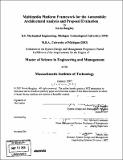Multimedia platform framework for the automobile : architectural analysis and proposal evaluation
Author(s)
Baughey, Kevin (Kevin L.)
DownloadFull printable version (20.54Mb)
Other Contributors
System Design and Management Program.
Advisor
Michael Cusumano.
Terms of use
Metadata
Show full item recordAbstract
The automobile industry is at a critical point in the development of in-vehicle entertainment and information features. The consumer electronics industry is changing dramatically in the areas of entertainment through audio and video playback, personal efficiency tools, and wireless communications. Equally as significant is the rapid development and feature migration that is occurring between four of the major mobile device categories; mobile phones, smart phones, PDA's, and media players. With this convergence occurring, automakers are finding it more difficult to satisfy the needs of consumers with respect to these new capabilities.In order for the automakers to establish a solution, a new framework needs to be established. The automakers are unable to satisfy this market desire through traditional technology delivery strategies, especially given the fast changing and complex interface that currently exists in this market space.This thesis establishes the framework used to identify and critically evaluate an external platform strategy for the purpose of satisfying the above need. The thesis draws upon leading literature to provide key attributes of successful external platform implementations. The first aspect of the framework established involves ensuring the need for an external platform through complexity and development clockspeed incompatibilities. The second section of the framework involves the evaluation of the architectural attributes that lead to external platform success. Finally, the stakeholders are identified and roles are established.The next phase of the analysis involves the evaluation of two prominent solution proposals using the established framework. These include the standards-based solution model that was developed at Automotive Multimedia Interface Collaboration (AMI-C), and the more recent commercial operating system proposal. (cont) These proposals are evaluated to determine if a specific proposal is better suited to capture the mobility market interface in the automobile than another. The analysis and framework provided it this thesis provides a basis for further tactical evaluation by the automakers that wish to meet the needs of the mobility market.
Description
Thesis (S.M.)--Massachusetts Institute of Technology, System Design and Management Program, 2007. Includes bibliographical references (p. 104-107).
Date issued
2007Department
System Design and Management Program.Publisher
Massachusetts Institute of Technology
Keywords
System Design and Management Program.